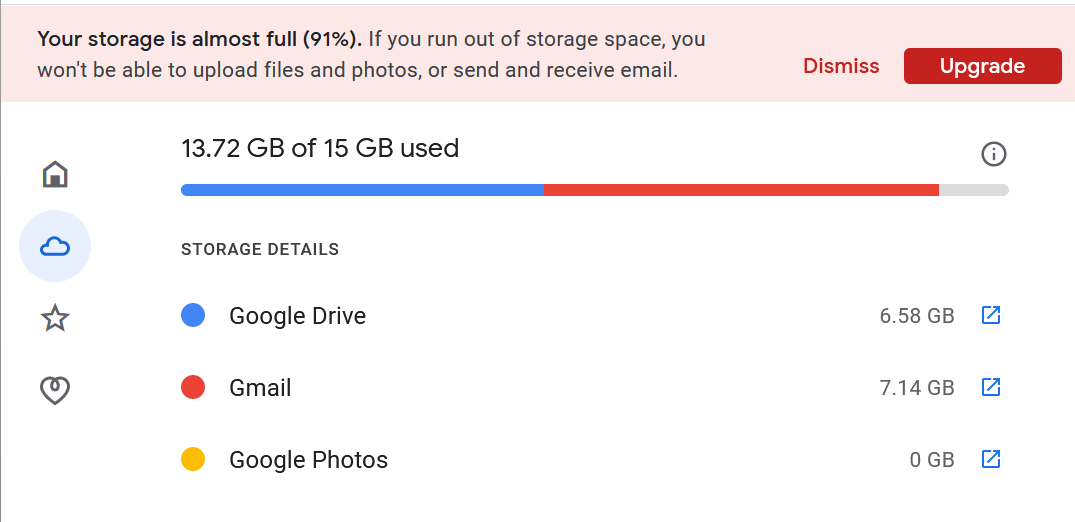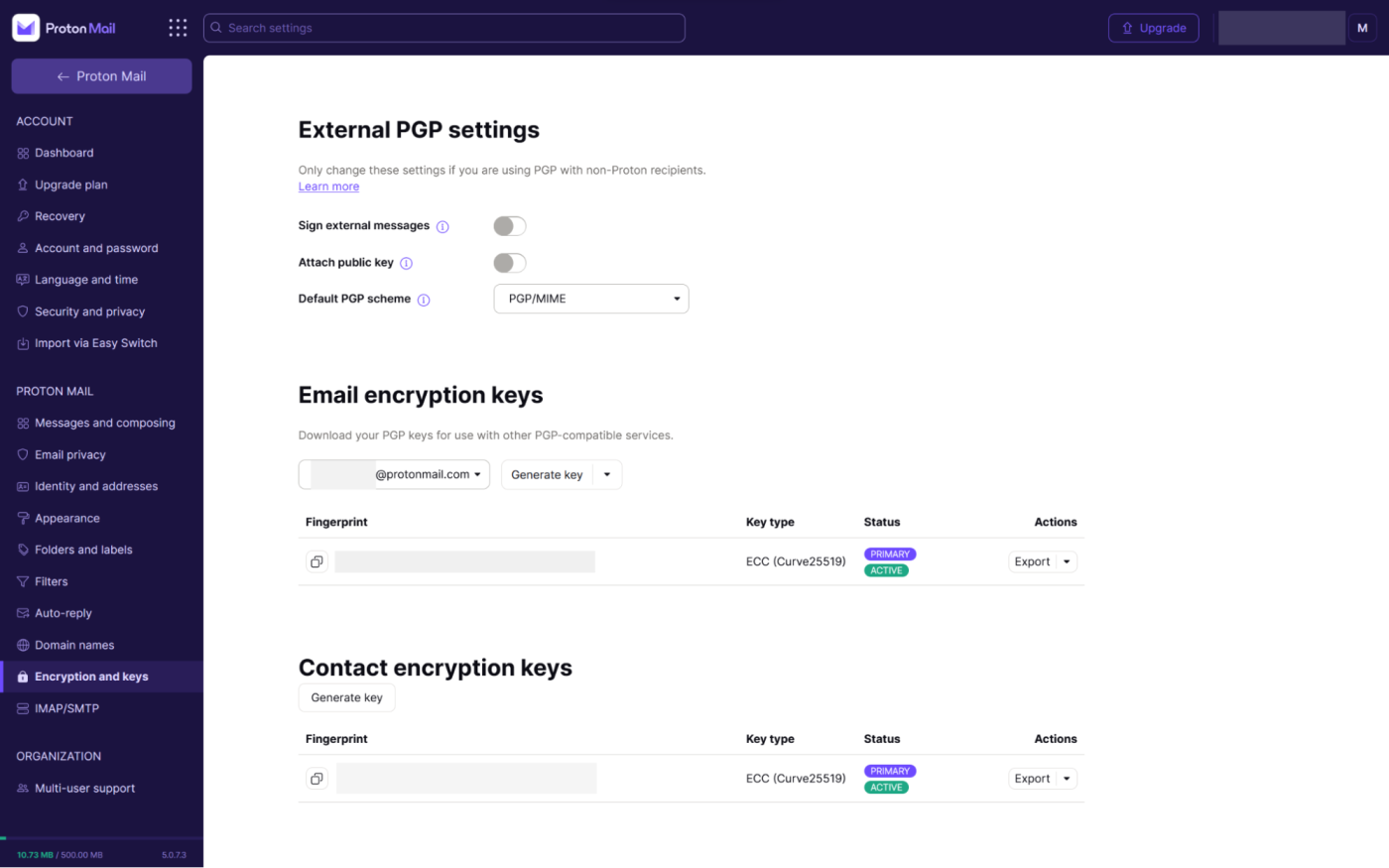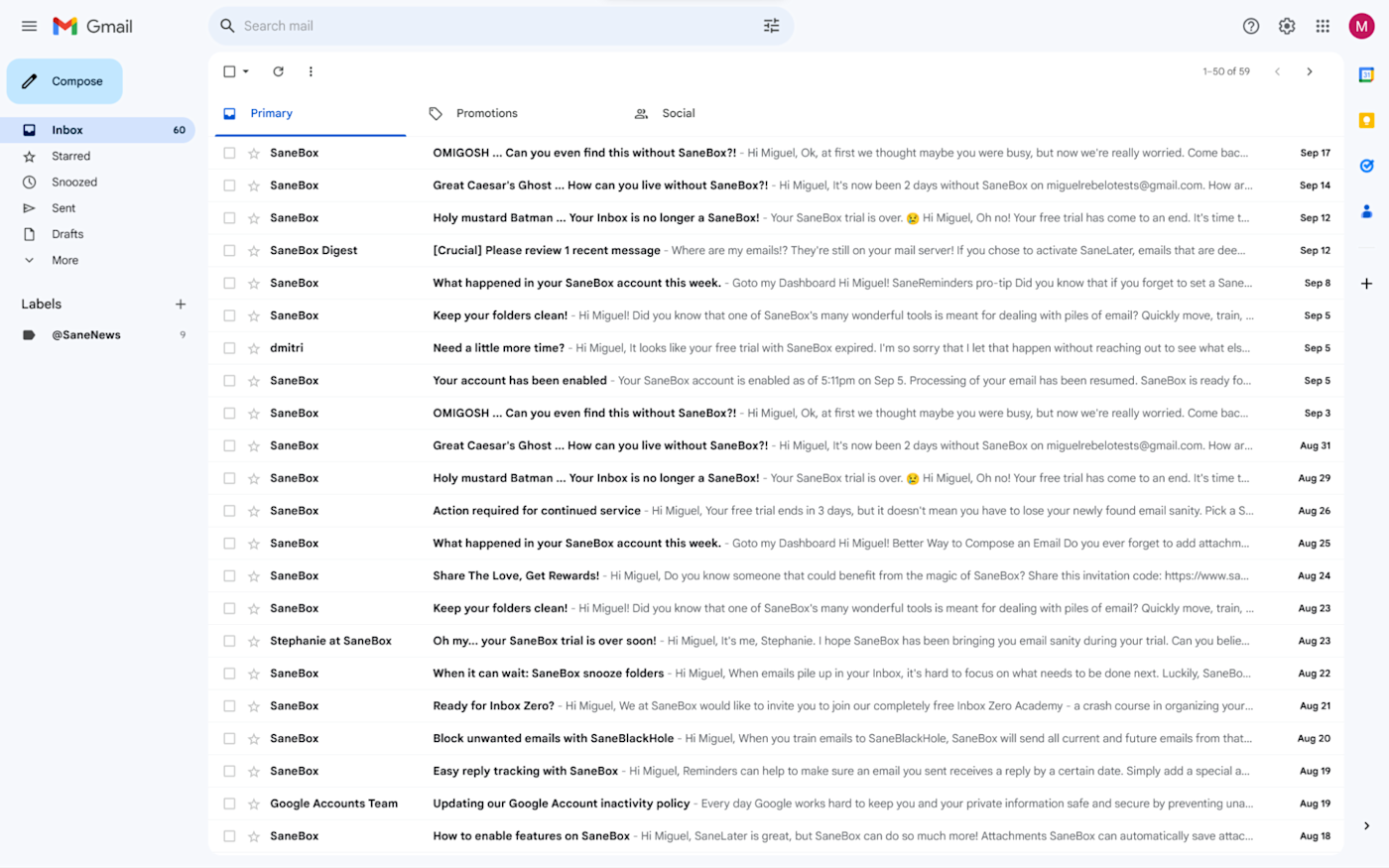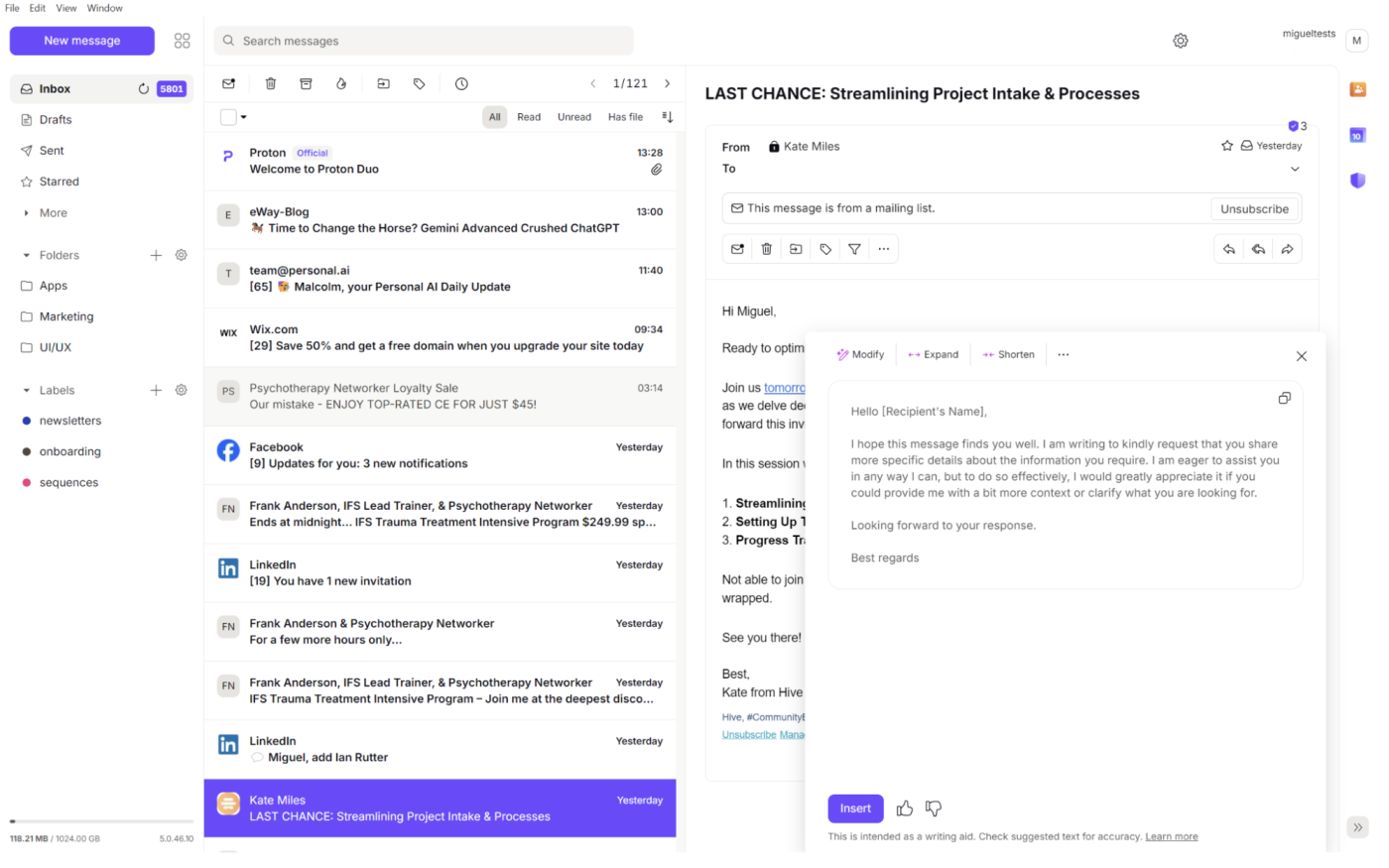Email is an internet dinosaur. But despite its age, it’s still how most people communicate at work, how marketers reach you, and how a lot of sensitive information is exchanged. And there are more email services and apps than ever to choose from.
Here, we’ll take a look at Gmail vs. Proton Mail. I’ve been using Gmail for 15 years, and I’ve used multiple Proton Mail accounts over the past two years—not for shady stuff, I promise. I dug into each one to take a deeper look and see how they stack up.
Whether you’re shopping around for an extra email account or fully transitioning from your old one, read on to find out what these services have to offer.
Proton Mail vs. Gmail at a glance
Proton Mail is the underdog with better privacy, facing a billions-of-users-strong Gmail with a better user experience and more integrations.
|
Proton Mail |
Gmail |
|
|---|---|---|
|
Pricing |
⭐⭐⭐ Free plan available; subscriptions start at $12.99/month |
⭐⭐⭐⭐⭐ Generous free plan; subscriptions available via Google One or Google Workspace |
|
Ease of use |
⭐⭐⭐⭐ Intuitive, but security features come with a learning curve |
⭐⭐⭐⭐⭐ Easy and intuitive |
|
Security |
⭐⭐⭐⭐⭐ Self-destructing and password-protected emails; end-to-end encryption (PGP) |
⭐⭐⭐⭐ Industry standards: TLS for client/server communications; 128-bit AES encryption for inbox contents at rest |
|
Privacy |
⭐⭐⭐⭐⭐ Zero-knowledge; no IP logging; under Swiss jurisdiction for legal purposes |
⭐⭐ User metadata is used for analytics, extra services, and monetization; under US jurisdiction |
|
Integrations |
⭐ No integration with other apps, except for Proton Drive and Calendar |
⭐⭐⭐⭐⭐ Integrates deeply with the Google software suite and with thousands of other apps via Zapier |
|
Email client integration |
⭐⭐⭐ Paid plan required to access Proton Mail accounts from other email clients (e.g., Outlook, Thunderbird, Apple Mail, etc.) |
⭐⭐⭐⭐⭐ Gmail accounts can be opened on almost any email client; Gmail mobile app opens email accounts from other providers |
|
AI |
⭐⭐⭐ Privacy-oriented; generates drafts, proofreads, and changes tone |
⭐⭐⭐⭐ Generates drafts, summarizes emails, and is available on other Workspace apps as well |
Proton Mail has superior privacy standards
Switzerland is more than precise clockwork, holey cheese, and neutrality. It has tight data protection laws too. Proton Mail is based in Switzerland, which makes it bound to:
-
The Swiss constitution’s Article 13 (general guidance on privacy rights)
-
The Swiss Data Privacy Act (unique protection for Swiss citizens and for data handled by Swiss companies)
-
The European Union’s GDPR laws (even though it’s not a member state)
Buried deep within the mountains, 1,000 meters underground, a nuclear-strike-proof bunker houses Proton Mail’s data center. A cool story for cocktail parties, but what’s more important is that it falls outside the jurisdiction of both the US and the UK. If any government wants to peek at user information, they’ll have to face Swiss courts first, and they’re pretty strict regarding personal data.
Proton Mail is ok with not having information about you. When you create an account, simply type in the account name and password, and you’re set. You don’t have to add any other personal information if you don’t want to, and the service doesn’t record your IP. Want to pay for a Proton Mail subscription with Bitcoin? You can. Zero-knowledge at its best.
Still, while Proton records very little data about you:
-
It can see your IP (it wouldn’t be able to communicate with your devices without it).
-
It can keep your credit card information (it couldn’t charge you for your subscription without it, if you’re a paying user).
-
It keeps other metadata, such as recovery email addresses, should you choose to add them.
Google does things differently. No, it doesn’t have data centers in locations that James Bond villains would approve of, but it has an impressive track record of both physical and digital safety. As for the way it treats its users’ data, well, it’s complicated.
On top of asking for a lot of personal information upfront during signup, Google tracks your IP and processes the data you own and metadata you generate through internal algorithms. All this data is used to support other Google products and services, such as showing shopping ads in your inbox and enabling the Smart Compose and Smart Reply features.
Google falls under US jurisdiction, so if you’re not comfortable with how the American government requests and handles personal information, this could be a major turn-off.
Proton Mail wins the privacy game by a large margin. But if you have a high-risk profession that usually gets on the nerves of governments or other powerful organizations, there are some caveats you should be aware of.
A French climate activist was arrested after Swiss courts ordered Proton Mail to track their IP. This means that if a request passes through court successfully, Proton has no choice but to collaborate with law enforcement and will start recording data about you. More recently, a Catalonian activist was also arrested because he added a recovery email to his Proton account—and, since it was an address tied to Apple ID, the investigators contacted Apple and were able to determine his identity.
So, if you’re an activist, journalist, or someone else who needs ultimate privacy, the safest way to use Proton Mail anonymously involves:
-
Paying for your Proton subscription with cryptocurrency. Make sure the transactions can’t be tracked on the blockchain and linked to your identity.
-
Use a good VPN service. Proton offers a VPN, but perhaps it’s best to mix up providers for extra safety. This also applies to other security software you use.
-
Use the Tor browser on top of the VPN. This routes your traffic via a secure network where your IP is hidden. Due to its architecture, this network can be slower and have a tighter bandwidth, so refrain from sharing or downloading large files while using it.
Avoid linking recovery emails or phone numbers to your account, especially if these can be traced back to your identity. If you’re afraid of forgetting your password, consider using a password manager. At the same time, develop the habit of backing up sensitive emails and deleting them in case your account is compromised.
Gmail has a better free plan
Gmail’s free plan is wonderful. The best, hands down. 15GB of free storage for all your emails, on polished mobile and web apps, with access to the entire Google software suite. If you manage your Google storage well, you can use it for decades without ever having to pay. What’s not to like?

If you need raw storage, a Google One subscription can bump your account to 100GB for $1.99 per month. If you want other features, such as custom email domains, you can upgrade to a Google Workspace subscription and empower the entire software suite starting at $6 per month.
How can Google be so generous with its free plan? Well, the company is huge, it has multiple revenue streams, and we’re not exactly sure how much our personal data plays into the bottom line (but it’s easy to suspect it’s one of the major factors).
On the other hand, Proton Mail is a smaller, newer company, and it isn’t in the data collection/analytics business. When you purchase a subscription at Proton Mail, you’re getting the extra features and also supporting their privacy-first approach. These reasons may explain why the free plan looks so modest in comparison:
-
You can only send 150 emails per day
-
There’s only 500MB of storage (upgraded to 1GB if you complete all the onboarding steps)
-
Organization is limited to 3 folders and 3 labels
-
Additional addresses and custom email domains aren’t supported
This should be ok for casual users, but if you want to move everything over to Proton Mail, it won’t last long. Notable features of the $12.99 per month Unlimited plan include:
-
Up to 15 email addresses and support for 3 custom domains
-
500GB of storage (shared with all Proton products)
-
Access to the short domain @pm.me to send and receive email
-
Unlimited organization (folders and labels)
-
Ability to open your Proton Mail account on a different email client (e.g., Outlook or Apple Mail)
-
Access to the Proton Calendar, Drive, VPN, and Pass
Proton Mail has more email security options
First, it’s important to note that both Gmail and Proton Mail provide great protection against people trying to get inside your email account. Most of it happens at the infrastructure level and also through features like multi-factor authentication. On top of it, both services also support physical authenticator keys that you have to plug into your computer to log in.
But Proton Mail has an edge because it operates on a zero-knowledge, end-to-end encryption principle. This means that no one, not even the people at Proton Mail, can read your email exchanges with anyone. To fully explain what this means, let’s get a bit technical.
Proton Mail uses PGP (Pretty Good Privacy) as a standard for communications. It contains a set of cryptography techniques and processes that ensure only the sender and the receiver of the emails have access to it. No one else can read or change the contents of an email, and the encryption keys to reveal them are never in the hands of anyone else.

In contrast, Gmail uses standard TLS (Transport Layer Security), which secures messages sent between users and Google servers. This is different from PGP because it lets Google keep the encryption keys that reveal your data. As for the emails already in your inbox, they’re protected by industry-standard 128-bit AES (Advanced Encryption Standard). Google’s standards are excellent, but the fact that it holds your encryption keys means that your data is visible to Google algorithms and whoever Google provides access to (e.g., court mandates).
There’s only one circumstance in which Gmail may provide something close to zero-knowledge: when you subscribe to Google Workspace Business Plus (for $18 per user per month), you can set up client-side encryption. This secures all messages and files before they reach Google’s servers with your own encryption keys, so anyone on the outside won’t be able to read anything—not even Google.
However, both Proton Mail’s PGP and Gmail’s TLS + 128-bit AES can’t fully protect you from an account breach. If someone hacks your device and gains access to your email, they’ll be able to read everything just as you do. Here, Proton Mail has a couple of options that help keep your inbox protected if this ever happens, but you’ll have to actively use them and understand how they work.
The first extra feature is the possibility to send password-protected emails. Before sending the email, you set a unique password. When the receiver gets your email, they have to click a link to open that message and input the password to read it. Even if a hacker gains control of any of the two accounts, they won’t be able to read that email unless they find the password.
Password-protected emails are a great way to exchange sensitive information with users outside of Proton Mail too—however, for maximum convenience and security, both of you should use Proton Mail.
The other security option is self-destructing emails. When you send an email, you set an expiration date. And, as if it were Snapchat, once that date passes, the email disappears. By using both these features, you can send and receive sensitive information with peace of mind. Even if the worst happens, you know that your data will be safe.
Gmail is better for typical users
Privacy is important, but would you be willing to give up convenience and ease of use for it? When looking from this angle, Gmail has an edge, as it offers a set of features that make email more intuitive. It’s no Apple, but it’s working to create an accessible user experience for everyone.
Both the web app and the mobile app are fast and easy to use. When you log in on a computer, all your labels sit on the left side, with plenty of space in the middle and right side of the screen for all your emails organized in conversation threads. At the top of the list, you’ll always find the toolbar to carry out all the actions you need to keep emails organized.

Gmail sorts your emails into categories with a set of pre-made filters. For example, Google puts marketing emails in a separate Promotions tab. The same goes for emails from social networks, so you can keep things separate from your main inbox.
The Gmail mobile app also acts as an email client. If you have accounts with other providers or from a custom domain, you can still open and interact with them in your Gmail app (though it doesn’t do so as elegantly as, say, Apple Mail).
On the other side of the fence, Proton Mail is getting faster and more intuitive too. It’s starting to overcome the limitations set by strict security standards. For instance, you can now search for email content inside your inbox safely with client-side search, meaning the Proton Mail server doesn’t have to read your emails to give you the search results. Everything happens inside your browser without anyone else’s eyes on your data.

Despite the ease-of-use upgrades, Proton Mail may still turn out to be too complicated for users that don’t care that much about privacy. It’s a better match for those who could become cybercrime targets—think high-profile public figures, managers at big companies, or journalists, for example—where security is more important than convenience.
And if you’re part of this group, you can upgrade your account’s security with Proton Sentinel: a paid service that combines AI and human experts to monitor suspicious events and login attempts. It works 24/7 to keep targeted hacking attempts at bay.
Gmail is better as a baseline business email
When you decide to upgrade Gmail with a Google Workspace Business subscription, you get all the apps you need to run your business in a single package. Considering the price and the number of shiny tools you get, it feels like a bargain. They’re all connected in a way that creates a solid balance between security, collaboration, and productivity.
For example, you can quickly respond to comments on a Google Doc straight inside Gmail, or send Gmails directly from Google Docs. If you like these kinds of smart integrations, you can connect Gmail to Zapier and do the same with thousands of other apps you already use. This is the kind of integration power that Proton Mail just doesn’t have. Learn more about how to automate Gmail with Zapier, or get started with these examples.
Zapier is the leader in workflow automation—integrating with thousands of apps from partners like Google, Salesforce, and Microsoft. Use interfaces, data tables, and logic to build secure, automated systems for your business-critical workflows across your organization’s technology stack. Learn more.
You’ll also get access to the Google Admin Console, the central place to manage everything happening inside your business accounts. You can create user groups, investigate suspicious login attempts, and create special rules to keep data safe. The problem here is that these controls are way too advanced for general users, being a better match for IT or cybersecurity experts.
Proton Mail does have some other products to offer you:
-
Proton Drive for file storage and sharing
-
Proton VPN for secure and anonymous browsing on the web
-
Proton Calendar for scheduling your daily to-dos
-
Proton Pass, an identity management product that acts as a password manager and a tool to create email aliases; you can use these to sign up for websites without exposing your real email address
-
Proton Sentinel, a 24/7 AI and human expert monitoring service to stop suspicious actions in your account
In addition to the individual and family plans, Proton also offers custom packages for business use, on a per-user pricing basis. The main differences are higher total storage, advanced account protection, and user permission management.
The upside here is that Proton Mail is really focusing on its core values: privacy and security. If you deal with a lot of sensitive information at work—and can’t trust Google no matter how hard you try—this could be a great way to upgrade your email to better standards without spending a lot of time configuring everything. The downside? You won’t have out-of-the-box collaboration and productivity features. All that data will live inside Proton Island.
Regarding integration with email clients like Outlook, Thunderbird, or Apple Mail, Gmail lets you link your account to any of these clients and manage your mail from there, even on the free plan. And as I mentioned above, you can use the Gmail mobile app as an email client as well: add email accounts from other providers and keep everything in one place.
Proton Mail isn’t as generous here. You have to upgrade to a paid plan to open your Proton Mail account in other email clients, and you can’t add accounts from other providers to any of the Proton Mail apps.
Gmail’s AI has more features, but Proton’s can be fully private
Google is integrating AI features across Workspace under the name of Gemini. With it, you can start writing from scratch on Docs, generate images for your presentations in Slides, and quickly generate tables in Sheets. The main entry point to these tools is at the top-right corner of your screen: click the Gemini star to open the side tab and start prompting.
In Gmail, the Gemini tab offers different actions based on context. In your inbox, you can ask for a summary of your unread messages or to track a specific order. When opening an email, you can get an AI summary of the content and start a reply draft either on the side tab or in the reply input field. If the answer isn’t quite right, you can Retry with Google Search to add a bit more context, edit it to perfection, and send. Heads up: chat history isn’t saved, so be sure to save the gold nuggets you find.

Whenever you use one of Gemini’s features, your emails are sent to Google’s AI servers so they can generate an answer. The way the company treats your data is in their privacy policy, which may change depending on which paid plan you’re using—if you subscribe to the Google One AI Premium plan with a personal account (for $19.99/month) the rules aren’t as strict as a Google Workspace plus Gemini add-on setup (in this case, Gemini goes for $20/user/month on top of the regular subscription).
In contrast, Proton Scribe, Proton Mail’s AI writing assistant, isn’t as full-featured as Gemini, but it’s much more private. You can run it in two modes:
-
Proton’s zero-knowledge cloud. In this option, you send requests to their servers and get the generated responses in your computer. Your request is deleted on the server side, so no one will be able to look it up later.
-
If you want complete privacy, you can download the AI model and run the generation jobs locally on your computer. You’ll need a powerful machine—only those with dedicated NVIDIA or AMD GPUs with at least 6GB of RAM can play—but there will be absolutely no data going out of your device.

As for the AI tools it introduces in Proton Mail, it isn’t as impressive as Gemini. You can generate a reply draft from scratch, proofread what you write, and change the tone and style of the text. More may be added in the future, but it will take more time as privacy-oriented platforms need to be more creative when implementing AI-powered tools. You can access Proton Scribe as part of the Duo paid plan going for $19.99/month, or as a $2.99 add-on for Business plans.
ProtonMail vs. Gmail: Which should you use?
Proton Mail is better for people who could be victims of cybercrime or anyone who cares about complete privacy of their communications. The Proton Mail apps are easy to use and getting better, but you’re trading off convenience, flexibility, and integration possibilities for enhanced security and privacy.
Gmail, on the other hand, is better for most users, offering an intuitive user experience right out of the box, without having to meddle with the settings too much. In addition to email, it offers a lot of useful software and a great balance between productivity, collaboration, and security—but you may be paying for some of these features by sacrificing your privacy.
If you’re interested in AI, Gmail’s Gemini edges out for productivity uses, especially since it’s unlocked across all Google Workspace apps. Although it doesn’t have as many features, Proton Scribe offers a private take on AI tools, so if you want to keep your data safe and still get a productivity boost, it may be a better option in the long run.
There’s definitely a case for using both: you can use Gmail as the baseline inbox, helping you tackle most communication tasks while working with your team. Proton Mail can come and save the day for sensitive negotiations, exchange of medical records, or anything that’s best talked about behind closed doors.
One last tip: don’t forward sensitive conversations from your Proton Mail straight over to Gmail. Doing so would expose the data to Google’s servers.
Related reading:
This article was originally published in September 2022. The most recent update was in September 2024.